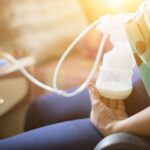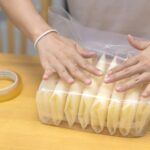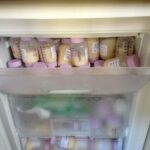How long a breast pump lasts will depend on how much milk you pump. Instead of thinking about a breast pump lasting a certain amount of days or months, consider the fact that breast pump motors are designed to last a specific number of hours.
Some breast pumps are designed to last a few hundred hours, and then the motor will need to be replaced. This varies based on brand, but the longest-lasting breast pump is the Spectra S1 or S2 with a lifespan of 1500 hours.
Do Breast Pumps Expire?
Breast pumps don’t expire. If the parts are still good and the motor still works, you can use the same breast pump after years have passed.
If the breast pump loses suction, you can just replace the parts. Because of this, they don’t necessarily have an expiration date or shelf life.
Medela Breast Pump Warranty
Medela breast pumps are extremely popular because of their warranty. Most Medela breast pumps come with the same warranty.
This warranty states that the pump portion of the breast pump will be covered for one year, and all other parts will be covered for 90 days.
This is based on the fact that your breast pump should last a year. Not all breast pumps do, but Medela is known to last this long due to the extended warranty they have when compared to other breast pumps.
[amalinkspro type=”showcase” asin=”B000LPZTQY” apilink=”https://www.amazon.com/dp/B000LPZTQY?tag=mominformedcom-20&linkCode=osi&th=1&psc=1″ new-window=”true” addtocart=”false” nofollow=”true” sc-id=”4″ imgs=”LargeImage” link-imgs=”false” specs=”COMPACT & LIGHTWEIGHT MOTOR: This single breast pump includes a compact and lightweight motor that fits easily into your purse, backpack, or tote bag. It’s easy to bring with you anywhere and anytime~~~RESEARCH-BASED TECHNOLOGY: Unique to Medela breast pumps, this research-based and patented design allows mothers to pump more milk in less time. It resembles a baby’s natural nursing rhythm for improved comfort and efficiency.~~~EASY-TO-USE CONTROLS: A single pumping kit with 24mm PersonalFit breast shields has been added for comfortable, efficient pumping, while easy-to-use vacuum controls let you choose the most comfortable setting.” btn-color=”#ff9900″ btn-text=”Buy on Amazon” alignment=”aligncenter” hide-prime=”0″ hide-image=”0″ hide-price=”0″ hide-button=”0″ width=”750″]Medela, Swing, Single Electric Breast Pump[/amalinkspro]
Taking Care Of Your Breast Pump
An important part of your breast pump lasting as long as it should be is taking care of the breast pump.
Cleaning certain parts properly, making sure the battery is charged regularly for rechargeable breast pumps and other key maintenance tips will guarantee that your breast pump lasts as long as it should.
First, remember to always wash your hands before touching your breast pump. Wash your hands before pumping. Wash them again before washing breast pump parts. This can help prevent bacteria from spreading to breast pump parts.
Cleaning Breast Pump Parts
Every piece of the breast pump that comes in contact with your breast or breast milk should be properly cleaned every time that it’s used.
This is because bacteria can be present in breast milk or on skin. If the parts on not properly cleaned, it can grow and then wind up in your breast milk.
Bacteria can be dangerous for babies, especially for little ones that were born premature or that have a weakened immune system.
View in gallery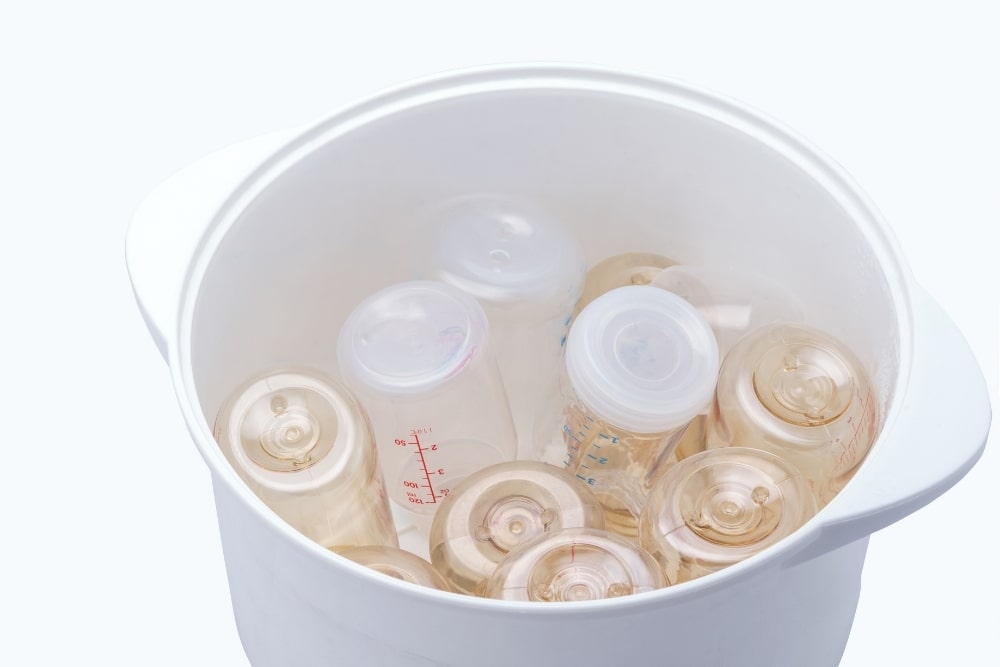
Sterilizing Breast Pump Parts/Sets
Sterilization is as important as cleaning. It’s important to get into a routine to make sure that your breast pump is sterilized daily.
Thankfully, there are a few different methods that will properly sterilize breast pump parts. This guarantees that you can find one for you!
How To Sterilize Breast Pump Sets And Parts
Sterilizing the parts of breast pumps is the same as sterilizing anything else! Boiling the parts in hot water for five minutes will effectively sterilize them.
To do this, you need to put the parts in a large pot of water. Put it on the stove, and turn the burner on high heat. Then, when the water is boiling, start a timer for two minutes.
After two minutes, you can trust that the breast pump parts have been properly sterilized.
How Often Should You Sterilize Breast Pump Sets/Parts
The same parts should be sterilized daily. This helps eliminate bacteria or germs that are not killed through regular cleaning.
If it’s not possible to sterilize these parts once daily, make sure to do it as soon as possible. Germs and bacteria can hide in the many parts of breast pumps.
Washing Breast Pump Parts
Breast pump parts should be washed after each use. You can use either the dishwasher or the sink to clean your breast pump parts.
When washing them in the dishwasher, you wash breast pump parts just like you would any other dish. Simply put them in the dishwasher and let them run through the cycle.
The main concern that people have about using the dishwasher is that it can make breast pump parts a slightly different color.
View in gallery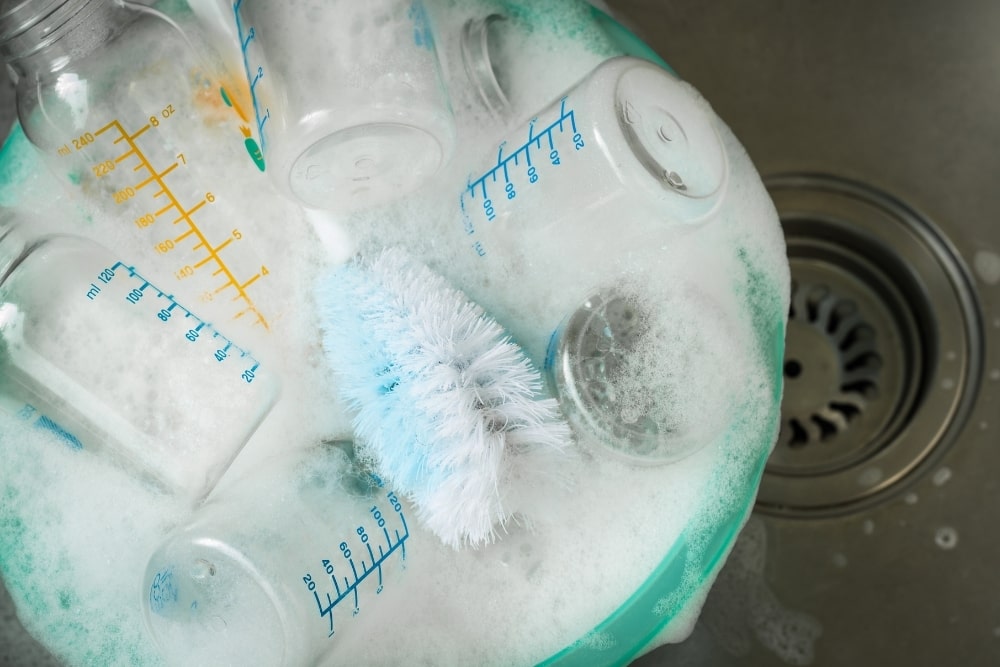
Usually, this doesn’t affect the function of the parts, though. Dishwashers are perfectly safe for breast pump parts. (If your dishwasher is able to sterilize breast pump parts, you can wash and sterilize them at the same time.)
You can also wash them in the sink, but there’s a certain way to do this. It’s highly recommended that your breast pump parts don’t touch the sink due to the bacteria that are found in most sinks.
To wash breast pump parts in the sink, use smaller rubber totes or large mixing bowls that can sit inside the sink. Then, wash them as you would any other dish.
Special soaps are designed to help remove breast milk residue both effectively and efficiently.
[amalinkspro type=”showcase” asin=”B01882J5UM” apilink=”https://www.amazon.com/dp/B01882J5UM?tag=mominformedcom-20&linkCode=osi&th=1&psc=1″ new-window=”true” addtocart=”false” nofollow=”true” sc-id=”4″ imgs=”LargeImage” link-imgs=”false” specs=”Pack of 3″ btn-color=”#ff9900″ btn-text=”Buy on Amazon” alignment=”aligncenter” hide-prime=”0″ hide-image=”0″ hide-price=”0″ hide-button=”0″ width=”750″]Medela Quick Clean Breast Milk Removal Soap, 6 Ounce (3 Pack)[/amalinkspro]
Do Not Let Breast Pump Parts Soak
It makes sense that if we let our dishes soak, it should be safe to let the parts of a breast pump soak. However, this isn’t true.
When the parts are left soaking in hot water, even if there’s soap in the water, it can create the perfect environment for bacteria to breed in.
Bacteria like hot, moist environments, which include warm, soapy water. The end result can be bacteria making it’s way to your breast milk.
Babies can then develop infections that can not only be painful for them, but they can have lifelong effects.
Use A Brush Designated For Breast Pump Parts
Don’t use the same sponge that is used for household dishes. These sponges and washcloths are known for having plenty of bacteria on them.
[amalinkspro type=”showcase” asin=”B0771H27BW” apilink=”https://www.amazon.com/dp/B0771H27BW?tag=mominformedcom-20&linkCode=osi&th=1&psc=1″ new-window=”true” addtocart=”false” nofollow=”true” sc-id=”4″ imgs=”LargeImage” link-imgs=”false” specs=”Two unique cleaning brushes specifically designed for breast pump parts~~~Folds discreetly for compact storage in travel, diaper, and breast pump bags~~~Brushes store neatly inside holder and stand up automatically when holder is opened~~~” btn-color=”#ff9900″ btn-text=”Buy on Amazon” alignment=”aligncenter” hide-prime=”0″ hide-image=”0″ hide-price=”0″ hide-button=”0″ width=”750″]OXO Tot Breast Pump Parts Compact Drying Rack with Detail Brushes, Gray[/amalinkspro]
This can then spread to your baby. Instead, it’s important that breast milk parts are washed with a sponge that is only used for those parts.
Let Parts Air Dry
When we use a towel to dry dishes, it can spread bacteria all over the surface. This results in bacteria that are in one small spot being spread all over the breast pump parts, increasing the risk to your baby.
View in gallery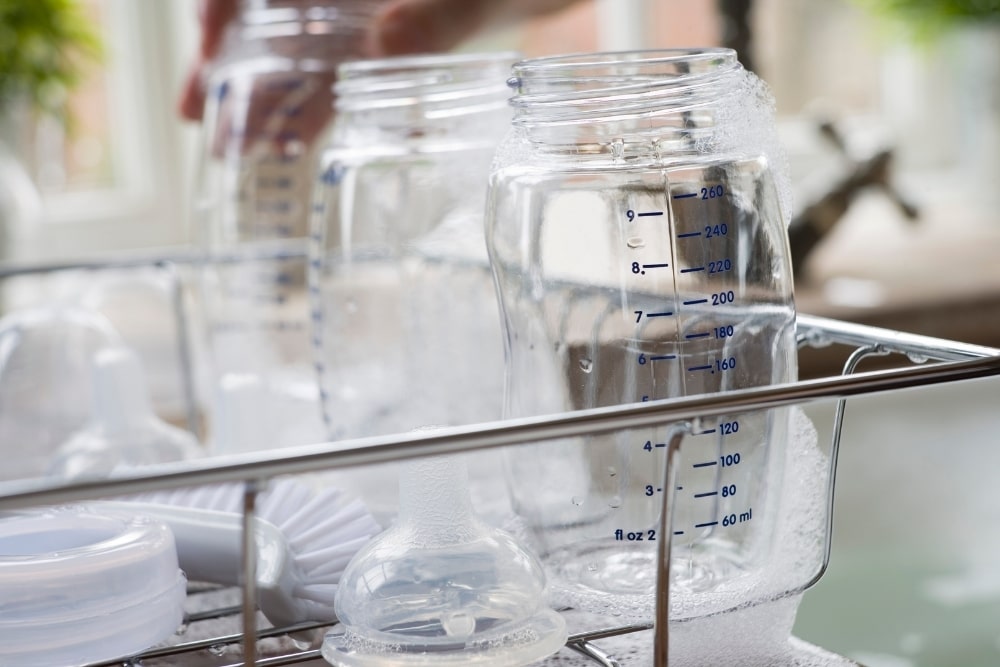
If bacteria isn’t on the breast pump parts but is on the towel, that bacteria can make its way into your baby. Instead, let them air dry.
Quick Wipes Are Not The Solution They Claim To Be
Quick wipes that are designed to specifically clean breast milk are a great idea, but there are a few problems with these. The primary problem with these is that they can’t reach every single part of breast pump parts.
They might seem like a great solution, but they aren’t the best idea. Instead, make sure to wash parts properly or pick up additional parts for your breast pump.
Using A Breast Pump At Work
When you’re at the office for at least eight hours a day, it’s not always possible to run home to feed your little one.
Thankfully, there are plenty of portable breast pumps available to make sure that you can conveniently pump your breast milk while you’re away from home.
Make sure that you take care of your breast pump properly while at work to reduce the risk of illness in your little one due to bacteria, and to help your breast pump last longer.
How To Store Breast Pump Parts At Work
Pumping breast milk at work isn’t as easy at home, but it’s definitely possible! Working mamas that have to pump breast milk at work are usually faced with the problem of what to do with their breast pump parts.
Bringing two washbasins, soap, etc. to work and taking the time to wash them after pumping is usually impossible.
Most people don’t even have breaks long enough to accomplish all of that. There are some quick and easy solutions for storing breast pump parts at work.
Storage Bags
Instead, you can store your breast pump parts in a large plastic bag in the refrigerator. Pick up gallon-sized Ziploc bags, or larger if you need larger.
View in gallery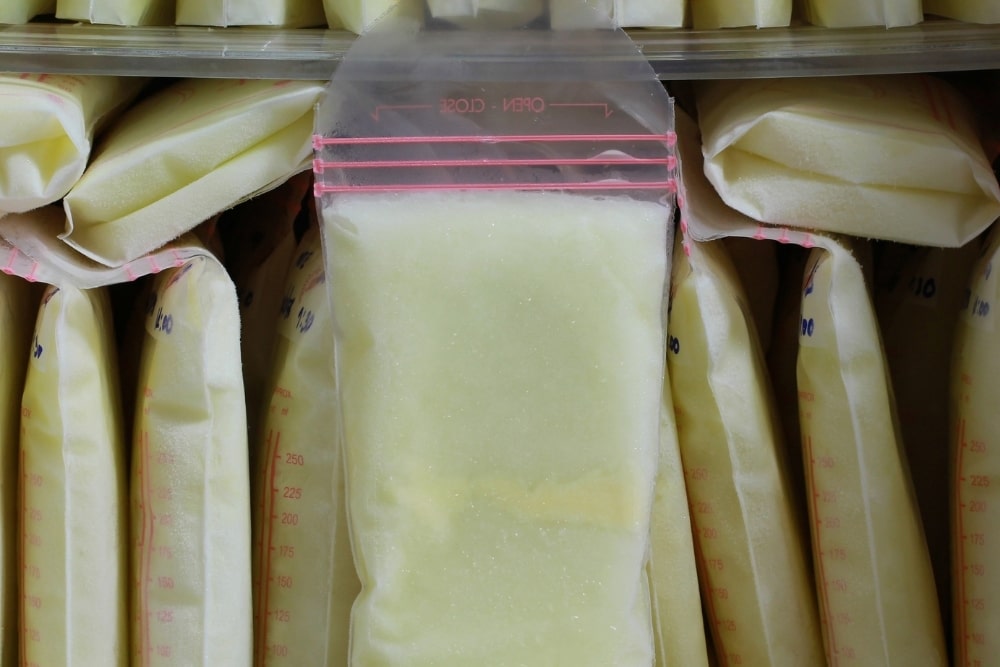
Then, place all breast pump parts that come into contact with your breast or breast milk in the bag. Store them in a refrigerator in the breakroom, or pick up a mini-fridge to stash them in.
At the end of the day, take them home and wash them as you normally would. Make sure to sterilize them!
If you have to store breast pump parts in the work fridge, and it feels awkward doing this with a see-through bag, pick up a storage bag that isn’t see-through.
There are plenty of these available on the market. Some are specifically designed for those that have to store breast pump parts in a communal fridge.
It’s a common myth that because the pump parts are in the fridge they do not need to be washed. This myth comes from the fact that bacteria are less likely to grow in colder temperatures, like those found inside a refrigerator.
However, this isn’t safe for babies, especially for ones that are born early under three months old, or have a weakened immune system.
Store them in the fridge to lessen the chance that bacteria will grow, and then make sure to wash them properly before using them again.
Pick Up Extra Parts
If you find yourself pumping more than once a day, it’s a great idea to pick up enough extra parts to give you a clean set for each pumping session.
When you use breast pump parts that are not properly cleaned to pump again, you run the risk of bacteria getting into your breast milk.
This can be dangerous for your baby. Most breast pump manufacturers have additional parts for sale specifically for this purpose.
In Conclusion
Most breast pumps will last at least a year. However, it’s always a great idea to purchase one with a warranty to make sure that you don’t spend more money than you have to on replacement parts.
Properly cleaning your breast pump can help it last longer and will help keep your baby safe.


